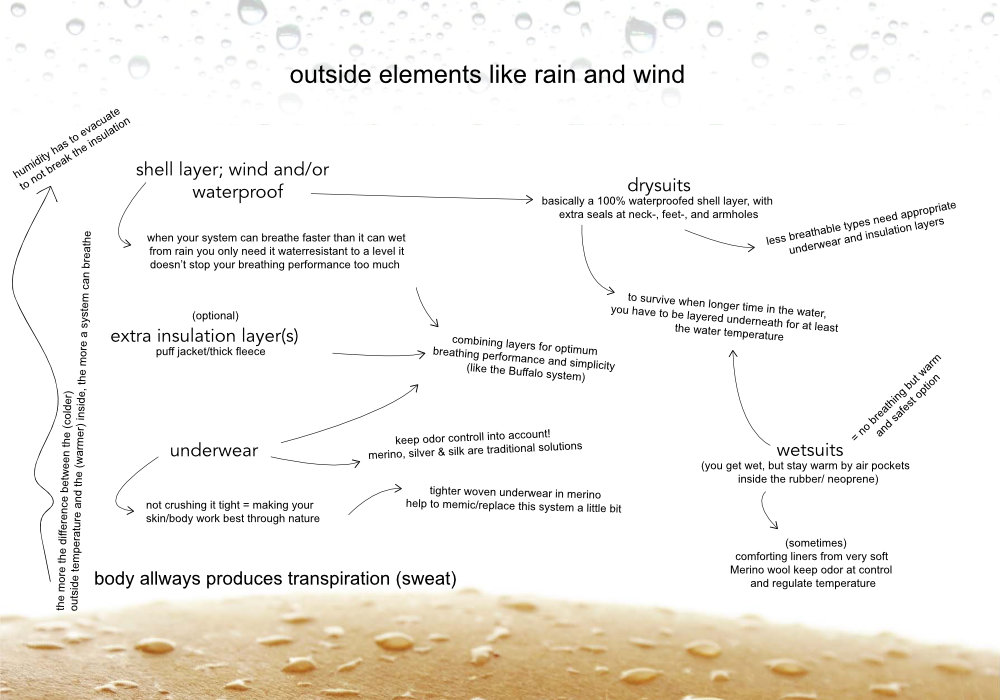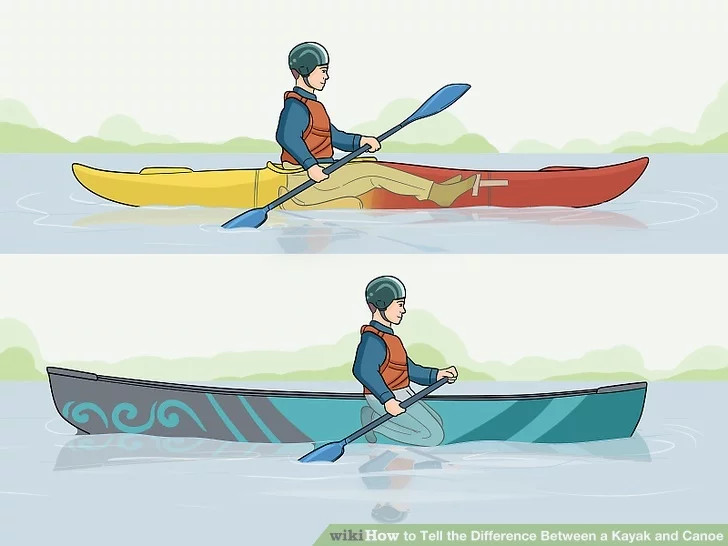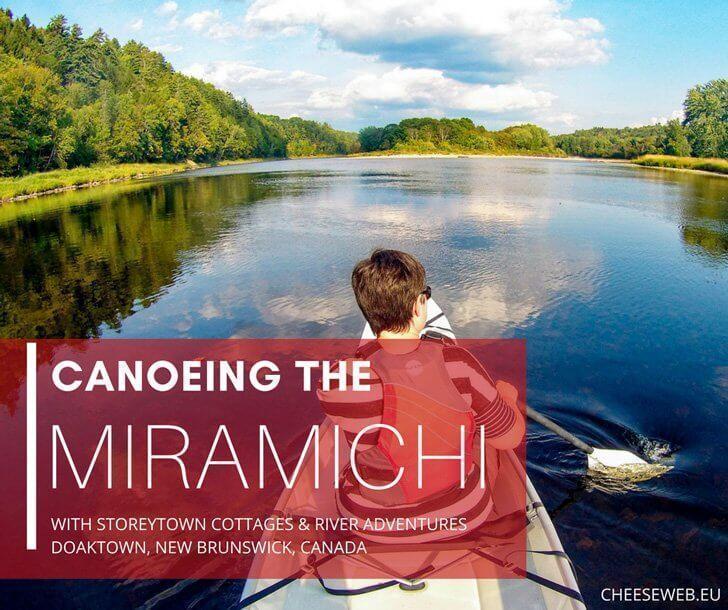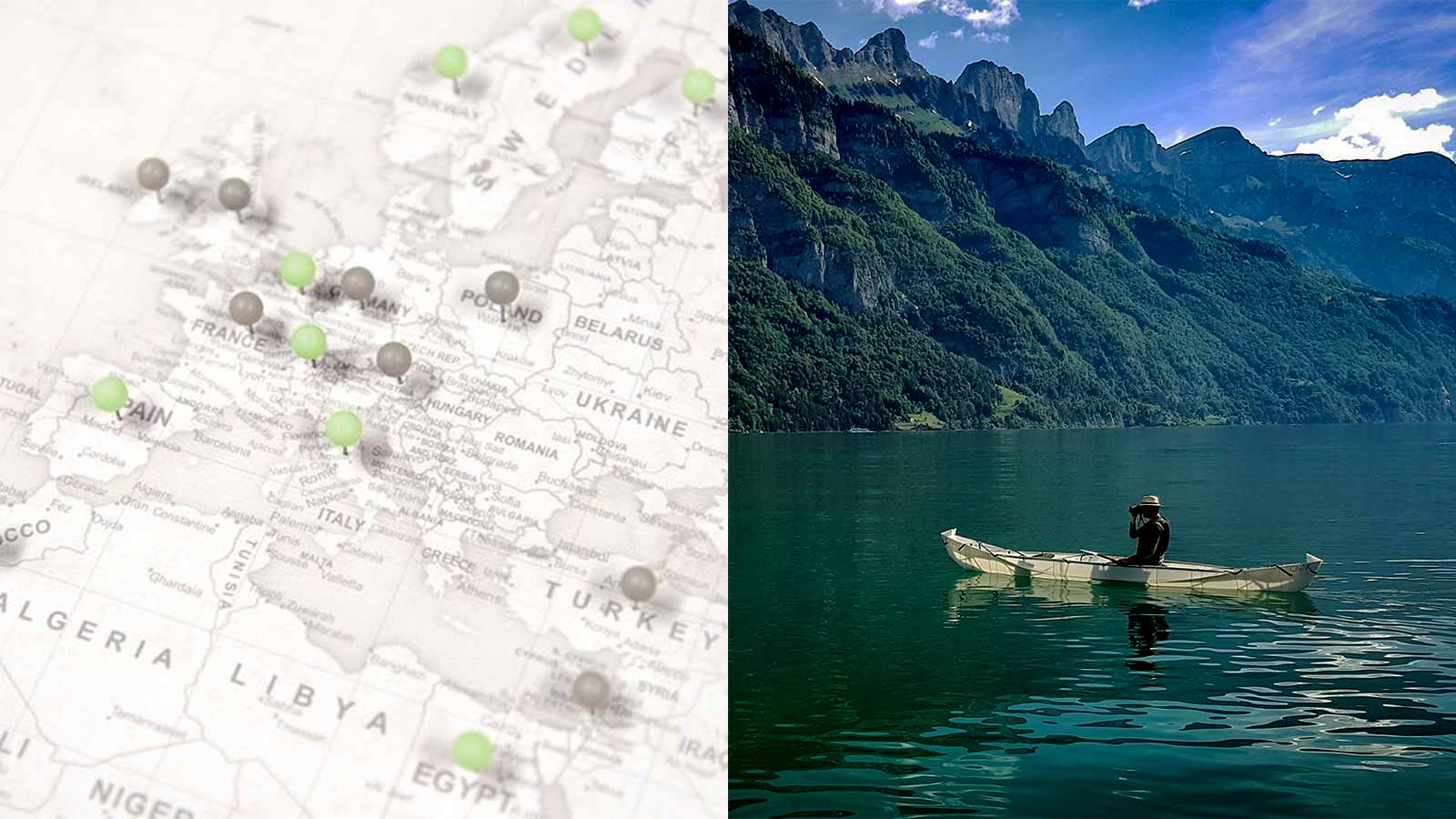We love paddling our foldable origami canoes in winter. When you feel safe paddling calm canals and rivers, like for example in our hometown Ghent, it’s not that difficult to get dressed warm enough. Just wearing the clothes you’d normally put on when going for a hike will suffice.
In this article, we will elaborate on how to stay comfortable when paddling in winter. We’ll also focus on what you can add to leave nothing to chance, because when you are always close to the water it can be dangerous to be unprepared. One rule is definitely true in all cases: keep some spare set of clothes at hand in a waterproof bag.
Infographic

Breathability
How to keep yourself dry?
Humidity doesn’t only come from outside the body. It’s not because it’s cold outside that you won’t sweat. You are always sweating, even when you are exercising in the cold. Therefore, it’s important to keep dry air close to your body. This will make it easier for your body to keep the right temperature.
If a significant amount of humidity gets too close to your body, you’re prone to get cold. But if you transport as much humidity as possible to the outer layers of your clothing to let it evaporate or even drip away, you’ll be insulated by the dryer in-between layers. This process is what outdoorsmen are calling “breathability”.
On top of that, air can be more easily kept warm when split into tiny pockets with little possibility of circulation in between. No easy feat, when you want to transport the humidity. More often than not, so-called capillary systems are used to achieve this. Humidity will condense less quickly into little water droplets this way, enabling it to get transported much faster. To make clothes breathe out humidity, you’ll need a temperature difference.
To achieve this transporting of humidity out of your clothes, your body itself – burning energy – will always be your first heat-source. Having enough food to burn is priority number 1. You might want to add electrical or other small and portable heating sources as well (for example zippo or active coal bags) when you fear your body is giving too little. We only recommend these heating systems in the event of somebody sitting still in the boat for a long time.
Restrictions of movement
When it’s cold, you’ll have to layer-up in a fashion that doesn’t restrict your movements too much.
Check the general arm flex you need when paddling a canoe, and make sure kneeling and crossing your legs is still possible. The shoulders of some jackets and insulation layers may be restricting your movements. Also, check your clothes on the noise they produce. Less expensive breathable rain pants and jackets tends to make plenty of noise. This noise will make you soak in less of your surroundings, thus having an impact on your paddling experience. In general, the stretch and suppleness of fabrics are paramount indicators for a great paddling experience.
Bad idea: As a solution to restricted movement, some people may want to wear bigger sizes than they need to. This isn’t a good idea because then you enable bigger air pockets. These bigger air-pockets enable humidity in vapor-form to condensate, something you, of course, don’t want.
Start with the core – underwear
When you insulate your core, you need less material on top. When you want to dress as efficiently as possible, close to the skin is where you will have to start. This layer also has the function of making sure humidity is immediately taken away from the skin. On top of that, underwear can have great value neutralizing smells.
Close to your body and far away from wind, it’s best to have an open and loose environment. This way your skin-structure can work at its best and keep you warm. Scandinavian underwear like the ones from Brynje and Woolpower are perfect examples that show this principle., Wearing fleeces with little channel structures like the Patagonia R1 series do an amazing job as well. These fleeces are made to release warmth. A great feat for those who don’t want to take off or put on layers all the time. Classic underwear with a high percentage of wool also does an amazing job. Wool has natural anti-odor characteristics, but may cause irritation when its yarns isn’t spun thinly enough, or when you happen to have a wool-allergy.
Decathlon and other brands can be great for the fleece-like or wool underwear at a reasonably low cost, but the looser and bigger knit Woolpower or other alternatives can be even better in keeping you warm and odorless. For the more fashion conscious under us brands like Icebreaker, Joe merino, Alchemy-equipment can be great options. Aside from the merino all-round Underwear – you can wear this all year round – we would also love to recommend the high tech stretch merino/silver/polyester shirts from Y-athletics for all year round.
On the undies side, it’s OK to wear your standard stuff, but do mind the same rules apply. Men could look out for less ball rub with Saxx or the extra touch of comfort many merino brands offer. The Best synthetic humidity evacuation vs durability and odor control we saw over at the undies, is from Ortovox, but again, value options from the likes of Decathlon or other value brands will not be far off.
Brands we love: Patagonia – Woolpower – Brynje – Houdini
Hands
When you are paddling with a good technique on flat water and when it doesn’t rain, you might not even make your hands wet at all. Thus, any warm glove will do.
When your hands will get a little bit wet, some breathable/waterproof gloves suffice. Especially the Sealskinz ‘ultragrip’ and Dexshell gloves deserve our recommendation. They are payable and have a great look.
When you are taking a more watery road, there only is the Neoprene road. Many Neoprene gloves are just fine, but you can check for reinforcements where you’ll grip your paddle, and general suppleness when you’d like something more.
When you want to take it one step further gloves used for divers suits with a fleece under-glove can be an option. Bear in mind though that they aren’t breathable and might get soaked in sweat.
Brands we love: Sealskinz – Dexshell – Extremities – Arcteryx
Feet
When kneeling or sitting with your legs crossed in a canoe it’s natural some water gets in, even when your shoes are waterproof.
Dexshell (the original) and Sealskinz have some great longer socks that are breathable and waterproof. When you like it waterproof you can use some latex or the Supskin socks, the lather being the only breathable option. To go over these socks we advise dive shoes. Other alternatives almost always get too bulky for a comfortable sitting position. You have plenty of diving shoes on the market. Just make sure they are comfortable when kneeling or sitting with your legs crossed.
In-between Insulation Layers
Many options here. Fleece, synthetic or Down puff jackets, or wearing the combination of a Fleece and windbreaker. All are possible.
Down always had restricted performance once the humidity gets too high. Hydrophobic down like the likes of Nikwax and Downtek brought a change to this. But a jacket from Sierra Designs or RAB can easily cost you a couple of hundreds whilst still performing less than synthetic fleeces when it comes to offering warmth when they have gotten too wet.
Synthetic puff jackets or Fleeces are always a good option. You should however always consider how to protect them against the wind. Cold air can easily get in between the insulation channels of the garments, rendering their insulation useless. This is why they came up with wind breaking layers.
Brands we love: Reed – Klättermusen – Houdini – The North Face – Fjällraven – Patagonia – RAB – …
Shell-Layer Stopping Wind And/Or Rain
On top of your underwear and other insulation layers, it’s important to add something to stop the outside elements like wind and rain.
We call layers like these Softshells. At many occasions, a good softshell wicks humidity out at a faster pace than rain or snow can make it wet. This is on the condition your body keeps on producing enough warmth and you don’t have any layer in between that soaks up al the humidity (like for example a cotton T-shirt or pullover).
Any wind or rain stopping layer will to some extent stop the ability to move humidity out. So be careful with wearing softshells under a hard shell. Just one shell layer will always be better.
Be careful with the Goretex marketing. There are many other breathable materials that are just as good.
Brands we love: Klättermusen, Fjällraven, Polartec Neoshell, RAB, The North Face
Wetsuits And Drysuits
Although suits from Buffalo & Reed promise to dry up extremely fast, it’s recommended to get a drysuit that doesn’t get you wet at all and / or a wetsuit that will keep you warm. Not all wetsuits are fit for paddling. When buying one it’s important to get a good feel from them, as many diving oriented suits restrict your movements greatly. Do mind that you will always get wet in a wetsuit. Wet from your own sweat, as well as from the water. Wetsuits need great care, but will always be the safest option as drysuits can puncture. Patagonia will definitely have the most Eco-friendly solutions, but we always recommend doing some research. Try before you buy.
Drysuits will definitely be the most comfortable. Expect to spend some money when you want to get the best breathability here. We would warmly love to praise Dador here. Their Gravity suit is probably the best when it comes to breathability and flexibility at the shoulders and legs. We are currently testing this suit for inclusion in our webshop soon. According to us, it has better looks and details comparatively to the SupSkin suits. Supskin, however, has the only breathable dry-socks that look amazing.
Breathability
How to keep yourself dry?
Humidity doesn’t only come from outside the body. It’s not because it’s cold outside that you won’t sweat. You are always sweating, even when you are exercising in the cold. Therefore, it’s important to keep dry air close to your body. This will make it easier for your body to keep the right temperature.
If a significant amount of humidity gets too close to your body, you’re prone to get cold. But if you transport as much humidity as possible to the outer layers of your clothing to let it evaporate or even drip away, you’ll be insulated by the dryer in-between layers. This process is what outdoorsmen are calling “breathability”.
On top of that, air can be more easily kept warm when split into tiny pockets with little possibility of circulation in between. No easy feat, when you want to transport the humidity. More often than not, so-called capillary systems are used to achieve this. Humidity will condense less quickly into little water droplets this way, enabling it to get transported much faster. To make clothes breathe out humidity, you’ll need a temperature difference.
To achieve this transporting of humidity out of your clothes, your body itself – burning energy – will always be your first heat-source. Having enough food to burn is priority number 1. You might want to add electrical or other small and portable heating sources as well (for example zippo or active coal bags) when you fear your body is giving too little. We only recommend these heating systems in the event of somebody sitting still in the boat for a long time.
Restrictions of movement
When it’s cold, you’ll have to layer-up in a fashion that doesn’t restrict your movements too much.
Check the general arm flex you need when paddling a canoe, and make sure kneeling and crossing your legs is still possible. The shoulders of some jackets and insulation layers may be restricting your movements. Also, check your clothes on the noise they produce. Less expensive breathable rain pants and jackets tends to make plenty of noise. This noise will make you soak in less of your surroundings, thus having an impact on your paddling experience. In general, the stretch and suppleness of fabrics are paramount indicators for a great paddling experience.
Bad idea: As a solution to restricted movement, some people may want to wear bigger sizes than they need to. This isn’t a good idea because then you enable bigger air pockets. These bigger air-pockets enable humidity in vapor-form to condensate, something you, of course, don’t want.
Start with the core – underwear
When you insulate your core, you need less material on top. When you want to dress as efficiently as possible, close to the skin is where you will have to start. This layer also has the function of making sure humidity is immediately taken away from the skin. On top of that, underwear can have great value neutralizing smells.
Close to your body and far away from wind, it’s best to have an open and loose environment. This way your skin-structure can work at its best and keep you warm. Scandinavian underwear like the ones from Brynje and Woolpower are perfect examples that show this principle., Wearing fleeces with little channel structures like the Patagonia R1 series do an amazing job as well. These fleeces are made to release warmth. A great feat for those who don’t want to take off or put on layers all the time. Classic underwear with a high percentage of wool also does an amazing job. Wool has natural anti-odor characteristics, but may cause irritation when its yarns isn’t spun thinly enough, or when you happen to have a wool-allergy.
Decathlon and other brands can be great for the fleece-like or wool underwear at a reasonably low cost, but the looser and bigger knit Woolpower or other alternatives can be even better in keeping you warm and odorless. For the more fashion conscious under us brands like Icebreaker, Joe merino, Alchemy-equipment can be great options. Aside from the merino all-round Underwear – you can wear this all year round – we would also love to recommend the high tech stretch merino/silver/polyester shirts from Y-athletics for all year round.
On the undies side, it’s OK to wear your standard stuff, but do mind the same rules apply. Men could look out for less ball rub with Saxx or the extra touch of comfort many merino brands offer. The Best synthetic humidity evacuation vs durability and odor control we saw over at the undies, is from Ortovox, but again, value options from the likes of Decathlon or other value brands will not be far off.
Brands we love: Patagonia – Woolpower – Brynje – Houdini
Hands
When you are paddling with a good technique on flat water and when it doesn’t rain, you might not even make your hands wet at all. Thus, any warm glove will do.
When your hands will get a little bit wet, some breathable/waterproof gloves suffice. Especially the Sealskinz ‘ultragrip’ and Dexshell gloves deserve our recommendation. They are payable and have a great look.
When you are taking a more watery road, there only is the Neoprene road. Many Neoprene gloves are just fine, but you can check for reinforcements where you’ll grip your paddle, and general suppleness when you’d like something more.
When you want to take it one step further gloves used for divers suits with a fleece under-glove can be an option. Bear in mind though that they aren’t breathable and might get soaked in sweat.
Brands we love: Sealskinz – Dexshell – Extremities – Arcteryx
Feet
When kneeling or sitting with your legs crossed in a canoe it’s natural some water gets in, even when your shoes are waterproof.
Dexshell (the original) and Sealskinz have some great longer socks that are breathable and waterproof. When you like it waterproof you can use some latex or the Supskin socks, the lather being the only breathable option. To go over these socks we advise dive shoes. Other alternatives almost always get too bulky for a comfortable sitting position. You have plenty of diving shoes on the market. Just make sure they are comfortable when kneeling or sitting with your legs crossed.
In-between Insulation Layers
Many options here. Fleece, synthetic or Down puff jackets, or wearing the combination of a Fleece and windbreaker. All are possible.
Down always had restricted performance once the humidity gets too high. Hydrophobic down like the likes of Nikwax and Downtek brought a change to this. But a jacket from Sierra Designs or RAB can easily cost you a couple of hundreds whilst still performing less than synthetic fleeces when it comes to offering warmth when they have gotten too wet.
Synthetic puff jackets or Fleeces are always a good option. You should however always consider how to protect them against the wind. Cold air can easily get in between the insulation channels of the garments, rendering their insulation useless. This is why they came up with wind breaking layers.
Brands we love: Reed – Klättermusen – Houdini – The North Face – Fjällraven – Patagonia – RAB – …
Shell-Layer Stopping Wind And/Or Rain
On top of your underwear and other insulation layers, it’s important to add something to stop the outside elements like wind and rain.
We call layers like these Softshells. At many occasions, a good softshell wicks humidity out at a faster pace than rain or snow can make it wet. This is on the condition your body keeps on producing enough warmth and you don’t have any layer in between that soaks up al the humidity (like for example a cotton T-shirt or pullover).
Any wind or rain stopping layer will to some extent stop the ability to move humidity out. So be careful with wearing softshells under a hard shell. Just one shell layer will always be better.
Be careful with the Goretex marketing. There are many other breathable materials that are just as good.
Brands we love: Klättermusen, Fjällraven, Polartec Neoshell, RAB, The North Face
Wetsuits And Drysuits
Although suits from Buffalo & Reed promise to dry up extremely fast, it’s recommended to get a drysuit that doesn’t get you wet at all and / or a wetsuit that will keep you warm. Not all wetsuits are fit for paddling. When buying one it’s important to get a good feel from them, as many diving oriented suits restrict your movements greatly. Do mind that you will always get wet in a wetsuit. Wet from your own sweat, as well as from the water. Wetsuits need great care, but will always be the safest option as drysuits can puncture. Patagonia will definitely have the most Eco-friendly solutions, but we always recommend doing some research. Try before you buy.
Drysuits will definitely be the most comfortable. Expect to spend some money when you want to get the best breathability here. We would warmly love to praise Dador here. Their Gravity suit is probably the best when it comes to breathability and flexibility at the shoulders and legs. We are currently testing this suit for inclusion in our webshop soon. According to us, it has better looks and details comparatively to the SupSkin suits. Supskin, however, has the only breathable dry-socks that look amazing.

(Thomas wears this suit in the video at the beginning of this article)
When you want to stay at the dry suit front, but you don’t want it this expensive, you could check out the Reed products. At Reed you have some less breathable, but durable alternatives. Kokatat and other more expensive brands also offer great possibilities. But in our experience, they are not worth the extra money, especially comparatively to the Dador Gravity suit.
With our rough and hairy man legs we did experience some small leaks at the leg seals in our suit. The usage of some latex or the Supskin socks solved this problem.
Softshell On Steroids
Companies like Buffalo, Reed & Paramo came up with extremely fast wicking solutions, all offering systems that breath so fast you’ll have to wear less than in a traditional system.
Buffalo shines in its obscure no-nonsense with claims like “it can be dry in as fast as 15 minutes when you are highly active after being totally soaked in water” and in it being the most durable, easy to wash and most long lasting system when not even wearing underwear under it.
Paramo still demands to get layered. They sell a full system and you’ll have to give them a little more care than some other options. Though they are just fine for the heavy rain as any other hard-shell system just, Paramo relies heavily on the Nikwax care-products to offer extremely fast wicking performance instead of having a structural shell.
Reed has some fleeces with an extreme amount of air inside the fibers. The fleece can dry faster when wet as its fibers don’t allow soaking water in its liquid state, and water is its vapor state, such a fiber channel naturally transports the water inside-out. This material was first developed for use inside non-breathable drysuits, but seems breathtaking. Buffalo is using the same system however, but already combined with a durable wind-protective layer. Reed offers (less durable) outer shell jackets, to wear on top of their fleeces. They also offer Fleece suits and other perfect undergarment to wear under a dry suit. Also, their minimalist approach is easier and cheaper to order online, when compared to the Buffalo Systems, where you sometimes have to wait for months.
In general Buffalo, Reed & Paramo take advantage out of having as little layers as possible, and having as little air-pockets prone to condensation in between those air-pockets.
Longevity & ecology
All this gear can easily become an investment. To keep it operating as good as new, it’s important to carefully follow the manufacturer’s care instructions. In general be careful washing anything over 30°C and be economical with softeners.
Care products like Nikwax or Grangers are recommended, especially to maintain water repellent coatings on anything breathable/waterproof they are important. They make you garments last longer. The Nikwax company is focused on sustainability & ecology, so this is why we like them most.
Life-jackets and other safety equipment
Do mind that wearing a life-jacket is obligated by law at many destinations. Cold water swimming with clothes on is way harder than without. Also, having at least one light on the boat when it’s dark is obligated in many places. The temperature shock of falling into the water can already take away your consciousness. Only when you are a highly experienced paddler at spots you are familiar with, could you neglect to wear a life jacket, though we would never recommend this.

And when you go to those places where danger is always lurking around the corner, bringing a small PLB or AIS and wear waterproof clothes as described earlier.



